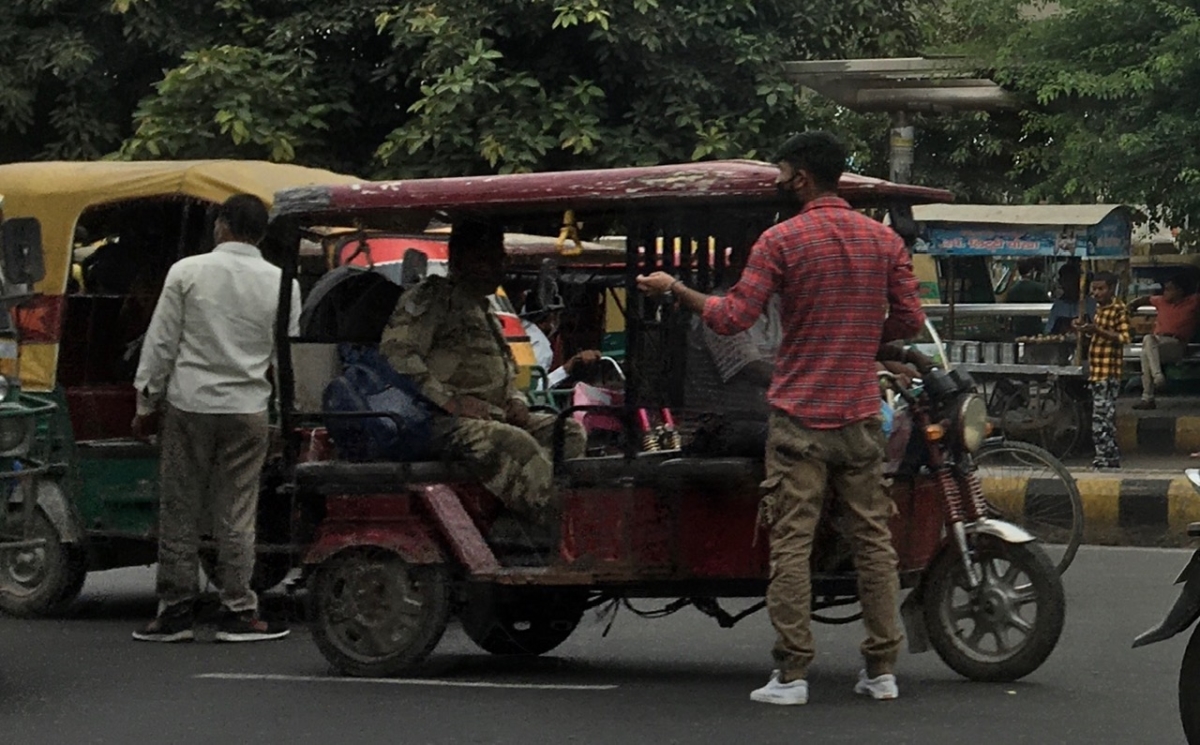
Rajesh’s day job is a rickshaw pulling( his back facing the camera)
Lately, Bollywood has been in the news for all the wrong reasons, doping is one of them. Ganja or cannabis is derived from the word Sanskrit gañjā means “powerful preparation from cannabis sativa” has been popular in India for ages, and is part of the cultural milieu in parts of the country, somewhat like Komban beers in the Kerala or mahua (5 kilos of dried mahua flower yield about 3 litres of alcohol) in Bengal, Bihar and Odisha.
The case is not very different in the NCR. Cannabis is widely grown, and readily available, usually smoked in a joint, or in a chillum, mashed with tobacco. And it’s a poor man’s dope that is popular with the middle-class youth, some of them prefer cannabis to alcohol. This is part of a global trend with many countries in the West and Latin America—including some states in the US, Canada, The Netherlands—legalising marijuana and cannabis, also referred to as weed, herb, pot, grass, bud, Mary Jane, and a vast number of other slang terms including ganja.
In NCR, be it Noida, Gurugram, or Faridabad, or parts of the national capital, ganja is available in every locality if you have an eye out for it. Mostly, it’s the rickshaw pullers, beggars, or local cigarette-paan shop, sometimes the washerman or the milkman can assist you in procuring quality stuff. And prices vary–Rs 100 for 10 grams of crude ganja (basically dried leaves) to a few thousand for a processed one—sold as a party drug.
Rajesh Kumar is an emaciated young man with a muscular frame, his big eyes conspicuous on his bony face with the broad jawline. He’s 23-year-old rickshaw puller operating around Malviya Nagar, Saket area of south Delhi. He has been peddling ganja for more than 12 years. He arrived in Delhi with his maternal uncle after his father’s demise, and started working in a dhaba in Kingsway Camp—his job was to wash utensils. His maternal uncle was also a rickshaw puller and peddled ganja to supplement his income. In a few years, Rajesh wanted to be on his own and be able to support his mother and three younger siblings. When he was 16, he had his brother, a year younger come to Delhi and help. They moved to south Delhi and started peddling drugs full time, though they continued to own a rickshaw. His brother died two years ago in a road crash. He is now married, has a house of his own, a one-room apartment near Sangam Vihar.
Rajesh finds it amusing that there’s so much hullabaloo about drugs in Bollywood. He survived in Delhi because of ganja. “Not only did I make some money, but also it comforted me when my body ached, or when I was depressed,” he explains in Hindi. “It kept me going by dissociating me from my worries, my state of being, my hopelessness,” he says dramatically.
He claims that there’s not a street in Delhi where you won’t find ganja being sold in some way or the other. Babloo, a beggar in CP, is on the move all the time, and when he’s not, he can be seen soaking in the sun in the central park. Then there are others who have earmarked places in the CP area, either inside a subway, or in corridors, or near the Palika area. They have been sitting there for years, and they have some good stuff. Babloo poses as an imbecile, walking around in tattered clothes, begging.
“I can see people and know,” he says, “and I just have to ask. And you know by their reaction. Sometimes they walk away, and return after a while and buy stuff, he explains. He has some 50 trusted customers which also include some bank employees, and auto and taxi drivers. The hotel staff come to them often for ganja for their customers. Sales pick up in the evening. He also has friends in the police, who get their cut and he gets to roam around freely.
Babloo is bemused about this whole talk about drugs. “It has always been like this,” he says and finds nothing has perceptibly changed in the last few years. He makes an interesting point, mostly a consumer is also a peddler. He loves ganja…and most of his customers, who buy in large quantities, sell it to others at a premium. He has contacts in Uttarakhand, Himachal and even in Nepal, who supply him “good stuff.” He collectively calls them “Nepali”.
“I sell ten grams of it in a small sachet for Rs 500, it gets sold for sometimes Rs 2,000,” he explains. His survival tactic — to deal with only known customers and those introduced by known customers—has stood him in good stead.
But whether it’s Babloo or Rajesh, both are fairly categorical that the use of cannabis is not new nor has it seen a recent rise, all they concede is that people are open about it. And they go about their business with dedication and treat it as a service to humanity as it helps people live with their unsurmountable difficulties. They think they do a service to people at large by making their lives desirable, and at times bearable. As Rajesh puts it, “Delhi is full of opportunities but it can also be very merciless. Dope helps.”
Rival leagues trigger players’ suspensions and a legal battle in Indian golf, for now
Former Delhi CM Kejriwal criticises Centre, Delhi govt over worsening air pollution, alleges AQI manipulation
Delhi Police raids Nangloi unit producing fake engine oil, seizes over Rs 1 crore worth…
Mukesh Sharma reimagines digital components as living matter in his solo exhibition ‘Decoding Digital DNA’
Nine accused were arrested in coordinated raids as police uncovered organised networks supplying mule bank…
Nearly 1.57 lakh PUC challans issued in two months as Delhi steps up GRAP enforcement…